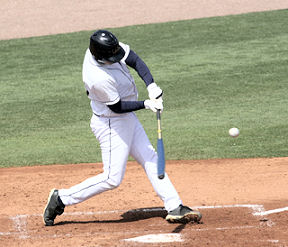The Noisy Game of Baseball
If a baseball player hits well early in the season, will he do just as well later on?
- More than 2 years ago
Halfway through the 2005 baseball season, John Olerud was having a great year with the Boston Red Sox. His batting average was .405, far better than that of most players. If someone had offered to wager with you on what his batting average would be for the rest of the season, what would you have bet?

It might seem like .405 would make sense, the same as the first half of the season. But if that had been your choice, you wouldn’t have done so well. In the second half of the season, Olerud’s batting average was down to .257. And if you’d used that method to bet on Henry Blanco of the Chicago Cubs, who had a first-half-season batting average of .151, you would have lost money too: in the second half of the season, his average was .305. Aaron Hill of the Toronto Blue Jays went from .359 to .226. And the list goes on.
In fact, according to a new analysis by Lawrence Brown of the University of Pennsylvania in Philadelphia, predicting that a player’s batting average will be the same in the second half of the season as the first half is about the worst plausible method out there. You’d do much better, in fact, by ignoring a batter’s individual average and simply predicting .248, the average across all players in Major League Baseball.
Lady Luck is the one messing up your bet. “If somebody does well for the first half of the season, they’re probably doing better than their native ability,” Brown says. In other words, chances are they’re getting lucky. The nasty thing about luck is that it tends not to hold, so the players’ averages often go tumbling down.
The hitters who’ve done well may be bummed, but the hitters who started out badly get a break. Brown’s analysis shows that for the same reasons, their averages are likely to pick up.
This phenomenon happens throughout life. Did you pay more for your house than most apparently similar houses? Bad news: It probably wasn’t just the lovely roses out front that drove the price up. Instead, you most likely paid too much, and when you go to sell it, odds are you won’t do as well.
Similarly, a busy period at a bank’s call center will probably be followed by a not-quite-so-busy period. Chances are that a very tall couple’s children will be tall but not quite as tall as they are. Statisticians call this phenomenon “regression to the mean.”
The trick is to separate out the effects of chance from the real differences in performance. The traditional method is to shrink everyone’s scores toward the average. So, for example, you might choose the point halfway between the average for all hitters and an individual’s first-half average.
Brown has developed new, more sophisticated statistical techniques for this purpose. The methods have wide applicability, but baseball made a handy test case since baseball fans are rabid keepers of statistics. His best method gave a 40 percent improvement over simply choosing the average across all players.
This method takes into account that some players batted many more times than others during the first half of the season. If a player has batted a lot, his batting average is more likely to reflect his real ability. So Brown’s method predicts that the player’s performance in the second half will be closer to his performance in the first half.
Which method is best depends, however, on the amount of initial data. After a single month, there’s still so little information that the best method is to just take the average across all players. After five months, though, Brown’s method does a lot better.
Even Brown’s best method couldn’t nail individual players’ future performances very precisely. Mostly, he says, that’s because baseball is a “noisy game,” with chance playing a large role. An oracle that knows each player’s precise ability could help some, he says. “But I can estimate that such an oracle, if she existed, could do no more than about 10 percent better than my best method—and perhaps not even that well.”
If you would like to comment on this article, please see the blog version.






